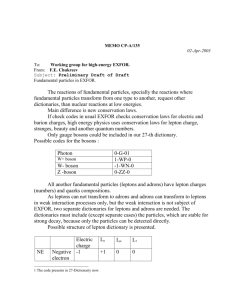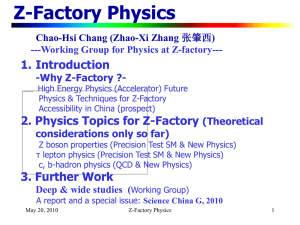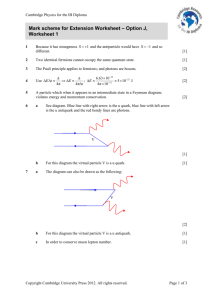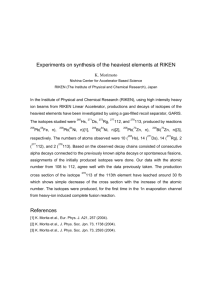3.7 Tau Physics - BES Collaboration Homepage
advertisement
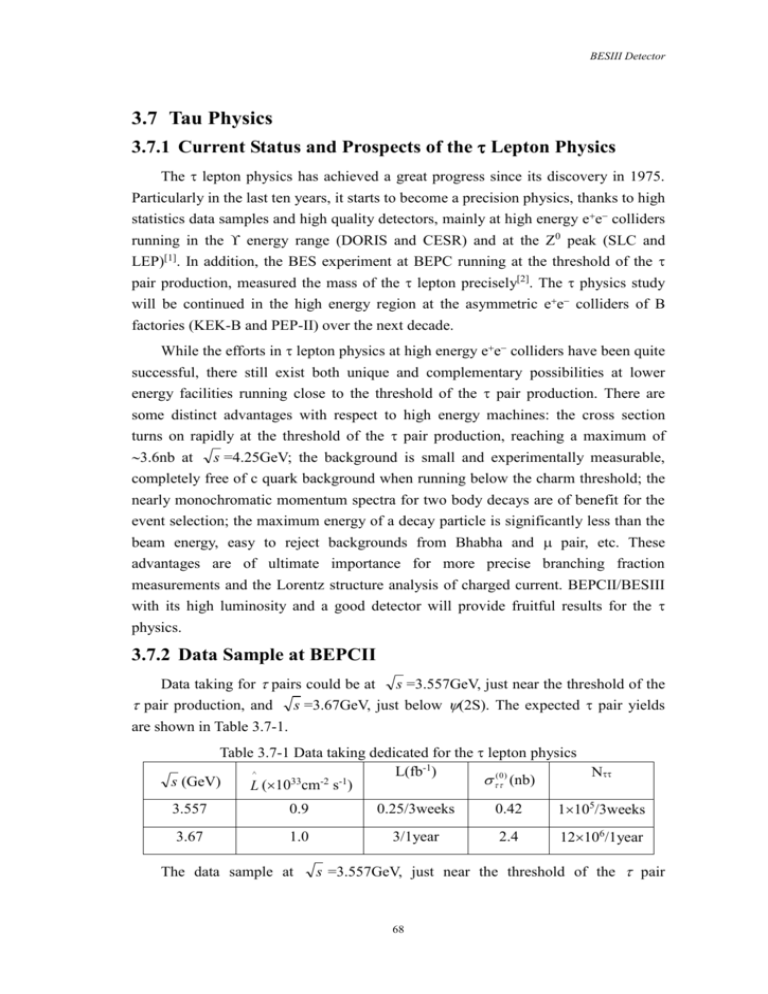
BESIII Detector
3.7 Tau Physics
3.7.1 Current Status and Prospects of the Lepton Physics
The lepton physics has achieved a great progress since its discovery in 1975.
Particularly in the last ten years, it starts to become a precision physics, thanks to high
statistics data samples and high quality detectors, mainly at high energy ee colliders
running in the energy range (DORIS and CESR) and at the Z0 peak (SLC and
LEP)[1]. In addition, the BES experiment at BEPC running at the threshold of the
pair production, measured the mass of the lepton precisely[2]. The physics study
will be continued in the high energy region at the asymmetric ee colliders of B
factories (KEK-B and PEP-II) over the next decade.
While the efforts in lepton physics at high energy ee colliders have been quite
successful, there still exist both unique and complementary possibilities at lower
energy facilities running close to the threshold of the pair production. There are
some distinct advantages with respect to high energy machines: the cross section
turns on rapidly at the threshold of the pair production, reaching a maximum of
3.6nb at s =4.25GeV; the background is small and experimentally measurable,
completely free of c quark background when running below the charm threshold; the
nearly monochromatic momentum spectra for two body decays are of benefit for the
event selection; the maximum energy of a decay particle is significantly less than the
beam energy, easy to reject backgrounds from Bhabha and pair, etc. These
advantages are of ultimate importance for more precise branching fraction
measurements and the Lorentz structure analysis of charged current. BEPCII/BESIII
with its high luminosity and a good detector will provide fruitful results for the
physics.
3.7.2 Data Sample at BEPCII
Data taking for pairs could be at s =3.557GeV, just near the threshold of the
pair production, and s =3.67GeV, just below (2S). The expected pair yields
are shown in Table 3.7-1.
Table 3.7-1 Data taking dedicated for the lepton physics
L(fb-1)
N
^
(0 ) (nb)
33
-2 -1
s (GeV)
L (10 cm s )
3.557
0.9
0.25/3weeks
0.42
1105/3weeks
3.67
1.0
3/1year
2.4
12106/1year
The data sample at
s =3.557GeV, just near the threshold of the pair
68
BESIII Detector
production, could be used for the mass measurement while the data sample at
s =3.67GeV, just below (2S), could be used for precise measurements of
branching fractions of decays and for the Lorentz structure analysis of charged
current. BESIII will take data at energy points such as J/, (2S) and (3770) or
s =4.14GeV. For energies above the pair production threshold, such as
3.686GeV(), 3.77GeV() and 4.14GeV( Ds Ds ), the expected pair yields are
shown in Table 3.7-2. These data samples are not as pure as those dedicated for the
lepton physics and may have some complications due to the background from the c
quark, but they are still more clean than those taken in the B energy region. Therefore,
good physics results can still be obtained with a high statistics at the expense of
efficiencies.
Table 3.7-2 Data samples of lepton as by-products of charm data taking
s (GeV)
^
33
-2 -1
L (10 cm s )
3.686 ()
3.77()
4.14( Ds Ds )
1.0
1.0
0.6
L(fb-1)
/year
5
5
3
(0 ) (nb)
N/year
4.2(E=1.2MeV)
2.95
3.56
21106
15106
11106
3.7.3 Physics of Leptons at BEPCII
From an experimental point of view, the lepton holds a special place among the
quarks and leptons. It is the only lepton massive enough to decay to hadronic final
states, probably the most sensitive lepton to new physics at higher mass scales. The
lepton constitutes an ideal laboratory to test the Standard Model and search for new
physics. The expected subjects of the lepton physics at BEPCII are listed as follows:
1. Precise Measurement of the Lepton Mass
The
currently
most
precise
measurement
of
the
mass[2],
0.25
-1
m =1776.96 00..18
data sample from a
21 0.17 MeV, is from BES, based on a 5pb
scanning near the production threshold. The statistical error could be reduced
greatly and the systematic error due to uncertainties in the acceptance and
reconstruction efficiencies could be improved with 50 times more statistics near the
threshold as shown in Table 3.7-1. For the relative beam energy spread of
2.73Eb10-4[3] at BEPCII, a precision of 0.1MeV for the mass measurement is
possible.
69
BESIII Detector
2. Measurement of the Upper Limit of the Neutrino Mass
The most stringent limit of the neutrino mass is 18.2MeV(95%CL)[4]. A total of
12106 pairs could be produced with BEPCII running at s =3.67GeV for one year
as shown in Table 3.7-1. The semileptonic decay of l l (l e, ) can be
chosen as tagging channels for the two hadronic channels of KK and 5.
Both decay channels and the 2-dimensional fit of normalized energy vs invariant
mass distribution of the hadronic final states can be used to get a better mass
sensitivity. From a Monte Carlo study, the upper limit of the neutrino mass at the
level of 1 digit (in MeV) is possible[5].
3. Measurement of the Strong Coupling Constant s
The hadronic decay is related to the strong coupling constant s (m ) at m
scale, through the ratio of the hadronic decay width of the lepton to its leptonic
decay width R=
( hadrons )
. So, s (m ) can be obtained from the
( e )
measurement of R, which can be obtained experimentally from the following two
approaches:
R=
( e ) ( )
,
( e )
or
R=
1 Br ( e ) Br ( )
.
Br ( e )
That means, through the precise measurement of partial widths or branching fractions
of the leptonic decays, we can get R, and finally the precise measurement of
s (m ) .
Using the renormalization group equation, one can evolve s (m ) at the scale
m to s (mz ) at the scale of mz and compare it with the direct measurement at the
Z0 peak. The error of s (m ) must also be evolved using the renormalization group
equation, so a modest precision of s (m ) results in a very high precision of
s (mz ) . The current experimental value of s (m ) is 0.3450.020, corresponding to
s (mz ) of 0.12080.0025, in excellent agreement with the direct measurement from
the hadronic Z0 decays s (mz ) =0.1190.003, but with a better accuracy [6].
4. Investigation of CP/T Violation
It is interesting to search for CP/T violation in the sector, proposed by many
70
BESIII Detector
theoretical physicists. An attempt of precision measurement of the electric dipole
moment dE of the lepton is one of the many efforts. The BES experiment has tried
to give some information on the CP/T violation through the measurement of the
momentum triplet product pe ( k1 k 2 ) in the production-decay sequence e(p1) +
e(p2) (k1) + e(k2) e , suggested by T.D. Lee. Using the existing
data sample collected at s =4.03GeV, BES has given a result A pe ( k1 k 2 ) =
-0.0270.031 0.006 [5]. The precision of this measurements can be improved using a
larger data sample of leptons.
5. Lorentz Structure Analysis of Charged Current
The current structure of the --W vertex can be studied by measuring the
lepton energy spectrum in the decay l l . The shape of the lepton energy
spectrum, sensitive to non-Standard Model contributions, can be characterized in
terms of 4 Michel parameters , , and , written in the rest frame as:
1
d
x2
4
m 1 x
4
{12(1 x)
(8 x 6) 24 l
P cos [4(1 x) (8 x 6)]}
dxd cos
2
3
m x
3
where P is the average polarization, is the angle between the spin and the lepton
momentum in the rest frame, and x=El/Emax is the lepton energy scaled to the
maximum energy Emax=( m2 ml2 )/2m in the rest frame.
The current world average values of 4 Michel parameters , , and are:
=0.7520.0085, =0.0310.031, =0.9840.031 and =0.7450.022[7]. The
precision of the measurements of the 4 Michel parameters , , and could be
improved, with a larger data sample of lepton, especially collected at the threshold
of the pair production.
6. Search for Rare and Forbidden Decays
Search for rare and forbidden decays, such as that with lepton number violation:
e+, e+ l l , …, that with a (pseudo-) goldstone particle: l X ( l =e,;
X=Majoron, familon, flavon, …), and so-called second class current: are
possible.
CLEOII has achieved a limit on the decay of of 1.410-4 (95% CL),
using a data sample of 3.2106 pairs[1,7,8]. The present upper limits on lepton-flavor
and lepton-number violating decays of the are in the range of 10-5 to 10-6. With a
samples of 107 events per year, an improvement of one to two orders of magnitude is
possible[6,9].
7. Precise Measurements of Branching Fractions of Decays
71
BESIII Detector
Accurate global analysis of all lepton decay channels, particularly those
involving K’s and multiple ’s, are possible, using a large data sample of lepton as
shown in Table 3.7-1 and 3.7-2. These precise measurements will allow the test of
universality of charged current of leptons to a new level. It will also provide a precise
determination of the vector and axial vector current spectral functions and some
useful information to test QCD.
Reference
[1] A.Stahl, Nucl.Phys.B(Proc.Suppl)98(2001)3-11; M.Davier and B.Jean-Marie
(eds.), Proceedings of the First Workshop on Tau Lepton Physics (Orsay, France,
Sept.24-27, 1990); K.K.Gan (edt.), Proceedings of the Second Workshop on Tau
Lepton Physics (Columbus, Ohio, USA, Sept.8-11, 1992); L.Rolandi (edt.),
Proceedings of the Third Workshop on Tau Lepton Physics (Montreux, Switzland,
Sept.19-22, 1994), Nucl.Phys.B(Proc.Suppl)40(1995); J.G.Smith and W.Toki
(eds.), Proceedings of the Fourth Workshop on Tau Lepton Physics (Estes Park,
Colorado, USA, Sept.16-19, 1996), Nucl.Phys.B(Proc.Suppl)55C(1997); A.Pich
and A.Ruiz (eds.), Proceedings of the Fifth Workshop on Tau Lepton Physics
(Santander, Spain, Sept.14-17, 1998), Nucl.Phys.B(Proc.Suppl)76(1999); R.Sobie
and M.Roney (eds.), Proceedings of the sixth Workshop on Tau Lepton Physics
(Victoria,
British
Columbia,
Canada,
Sept.18-21,
2000),
Nucl.Phys.B(Proc.Suppl)98(2001)
[2] J.Z.Bai et al., Phys.Rev.Lett.69(1992)3021, J.Z.Bai et al., Phys.Rev. D53(1996)20
[3] Yuan Changzheng et al., “-charm physics and restriction to the accelerator and
detector design”, to be published in High Energy Physics and Nuclear Physics (in
Chinese)
[4] ALEPH Collaboration, R.Barate et al., Eur.Phys.J.C2(1998)395
[5] Feasibility Study Report on BEIJING TAU-CHARM FACTORY, IHEP-BTCF
Report-03, Oct. 1996, IHEP, CAS, CHINA
[6] A.Pich, Nucl.Phys.B(Proc.Suppl)98(2001)385-396
[7] K.K.Gan, Nucl.Phys.B(Proc.Suppl)98(2001)397-416
[8] CLEO collab., J.Bartelt et al., Phys.Rev.Lett. 76(1996)4119
[9] CLEO collab., Phys.Rev.D61(2000)071101, D57(1998)5903, D55(1997)R3919;
Phys.Rev.Lett. 79(1997)1221
72

